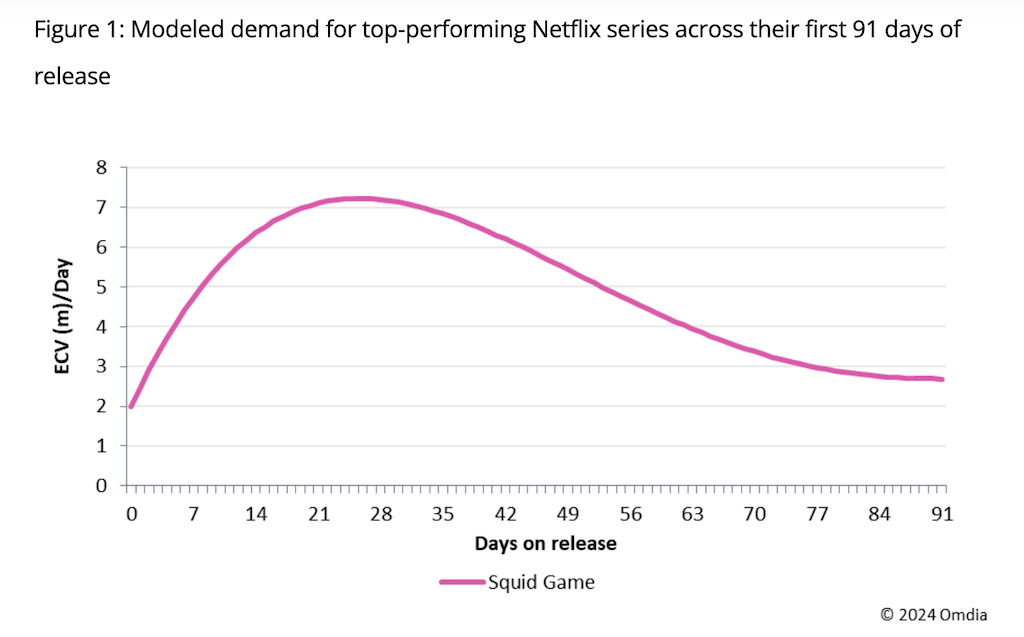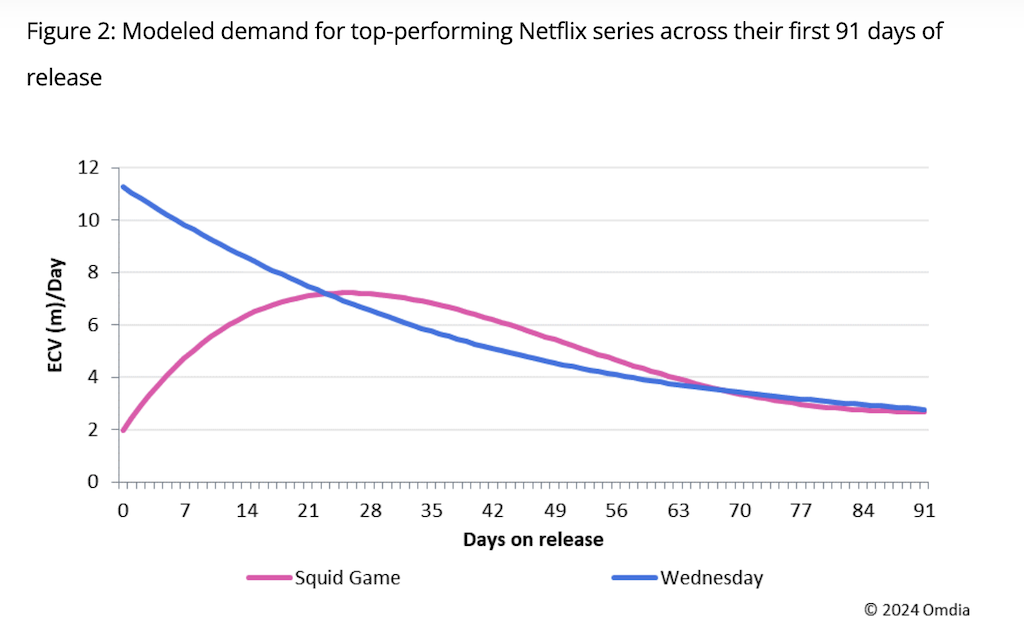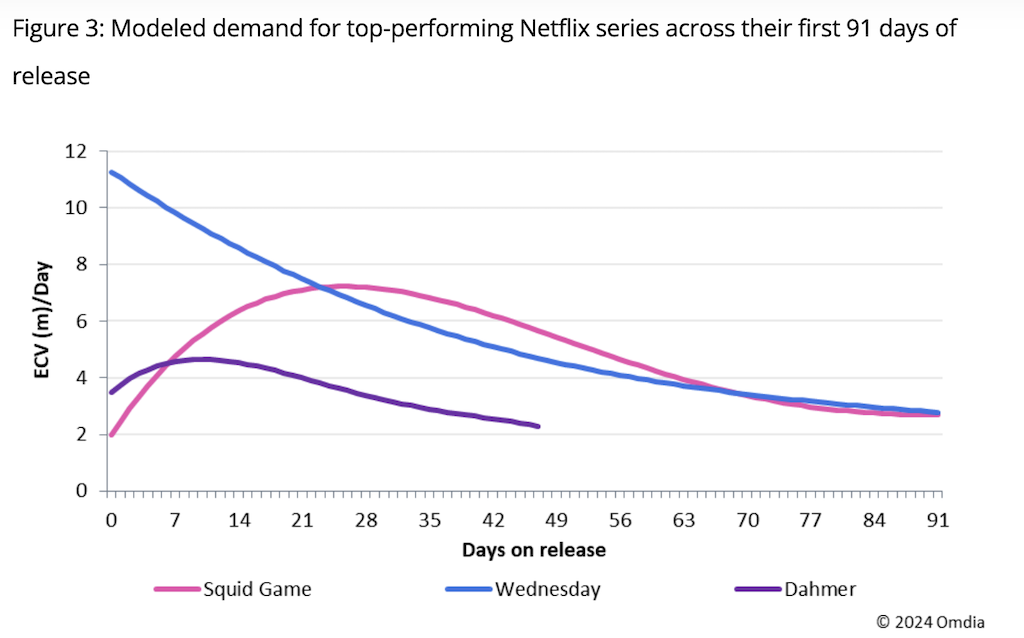
After more than 35 years of operation, TBI is closing its doors and our website will no longer be updated daily. Thank you for all of your support.
TBI Tech & Analysis: Can Netflix repeat ‘Squid Game’s success?
Squid Game‘s global success in 2021 reset the ambitions of globe-trotting drama and set new expectations for streamers. Omdia’s Matthew Evenson explores if the long-awaited sequel will reach similar heights.
In the nearly two and a half years since the Korean drama Squid Game took the world by storm, no other non-English-language Netflix title has come close to replicating the level of fervor seen for the dystopian gameshow drama.
With a long-awaited second season set to premiere in the second half of 2024, a deeper dive into the performance of the first season may reveal whether or not its success is likely to be repeated.
How Squid Game‘s success took Netflix by surprise
During an on-stage interview at the Recode Conference in September 2021, Netflix co-CEO Ted Sarandos was asked to highlight a show he was grateful to have on the service.
Rather than choosing a known, established hit, Sarandos highlighted the burgeoning success of the Korean series Squid Game.
At that time, the show had been on the platform for less than two weeks, but Sarandos was confident enough to claim that the show would become “our biggest non-English language show in the world.”
He further disclosed that the company had not seen that coming “in terms of its global popularity.”
A few weeks later, Netflix began releasing data on the top 10 viewed titles each week in what it called its bid to be more transparent regarding its shows’ popularity.
By this point, Squid Game had become the global sensation that Ted Sarandos had indicated, and the weekly viewing data divulged the extent of its success.
A huge success with small beginnings
From its launch on 17 September, 2021, Squid Game would go on to be watched for a total of 2.2 billion hours in its first 91 days of release, equivalent to 265.2 million complete viewings of the series (calculated by dividing the total viewing hours by the series’ runtime).
This equivalent complete viewing (ECV) metric is helpful to compare the performance of different titles, as analysis of title performance based just on hours viewed will inevitably favor titles that have a longer total runtime; since late June 2023, Netflix has adopted this metric for determining the ranking of its weekly top 10s.
 Figure 1 shows the modeled viewing demand for Squid Game across its first 91 days of release, utilising known data points based on the published viewing data from Netflix (the calculation for the first three known data points can be found in the Methodology section of the appendix).
Figure 1 shows the modeled viewing demand for Squid Game across its first 91 days of release, utilising known data points based on the published viewing data from Netflix (the calculation for the first three known data points can be found in the Methodology section of the appendix).
It presents the average number of ECVs per day since the show’s release. Working on the basis that a title is viewed less and less each day after its release, and thus the number of ECVs of a title increases at a slower rate over time, the modeled demand for a title when plotted should broadly decline from left to right.
However, as Figure 1 shows, demand for Squid Game increased in its initial weeks of release, reaching its peak after 26 days, before entering into the expected decline.
 For comparison, Figure 2 adds the modeled demand for Netflix’s most-viewed English-language series of all time, the fantasy drama Wednesday, which amassed a not dissimilar number of ECVs across its initial 91 days (252.1 million versus Squid Game’s 265.2 million).
For comparison, Figure 2 adds the modeled demand for Netflix’s most-viewed English-language series of all time, the fantasy drama Wednesday, which amassed a not dissimilar number of ECVs across its initial 91 days (252.1 million versus Squid Game’s 265.2 million).
The modeled demand for Wednesday follows a more typical pattern seen among Netflix titles analysed by Omdia, where demand peaks for the show at the point of its release and subsequently falls over time.
This difference indicates that Squid Game gathered momentum during the early stages of its release to become something of a sleeper hit for Netflix, whereas Wednesday found its audience more immediately upon release.
Many of Netflix’s other top-performing titles follow the pattern seen by Wednesday. One notable exception is Ryan Murphy’s series Dahmer – Monster: The Jeffrey Dahmer Story (referred to as Dahmer in this report), which currently ranks third in Netflix’s top 10 English-language series, and Figure 3 adds the modeled demand for this show as a comparison. Fewer data points were available for Dahmer, as Netflix only reports data for titles in the top 10 of each week.
Adding Dahmer to this comparison demonstrates not only the enormity of the viewership for both Squid Game and Wednesday but also the greater surge in demand for Squid Game versus Dahmer. Demand for Dahmer increased 33% from release day to its peak, at day 10, whereas demand for Squid Game increased 263% from release day to its peak at day 26.
 Beyond Squid Game, one of Netflix’s other major non-English language hits was La Casa de Papel (aka Money Heist) from Spain. Parts three, four and five of the show currently occupy the second, fourth, and fifth spots, respectively, in Netflix’s all-time top 10 non-English language series.
Beyond Squid Game, one of Netflix’s other major non-English language hits was La Casa de Papel (aka Money Heist) from Spain. Parts three, four and five of the show currently occupy the second, fourth, and fifth spots, respectively, in Netflix’s all-time top 10 non-English language series.
The show’s fifth and final season was released in two parts toward the end of 2021: the first five episodes were released on September 3, 2021 and the final five episodes were released on December 3, 2021. As such, the modeled demand for La Casa de Papel: Part 5 in Figure 4 only tracks demand for the five episodes released on September 3, 2021.
As the fifth and final season of a popular show, it’s not unsurprising that demand for the new season would be somewhat front-loaded, with the show’s more passionate fans more likely to watch new episodes as soon as they become available. However, the gradient of the drop in demand in the show’s first 14 days of release shows the extent to which viewing was concentrated in this early period.
Does Netflix need another Squid Game?
When trying to gauge whether Squid Game’s success could be repeated, it becomes clear that several considerations gave the show an advantage.
Its name and the distinctive design of particular aspects of the show helped it to stand out among other titles both on Netflix and in the wider media landscape: the green numbered tracksuits worn by the contestants, the pink jumpsuits worn by the faceless guards, the giant robotic doll from the show’s red light, green light game.
It’s also worth bearing in mind that Netflix has been investing in non-English content for many years as part of its expansion into markets outside North America, with the aim of using locally produced content to draw in new subscribers in those markets.
Not only has the proportion of non-US titles increased (broadly) across recent years, but the overall number of original titles produced by Netflix has increased too.
Local markets are better served by local content and there is simply more content being released each year for subscribers to watch. A near majority of original titles from prior years are still available to watch, and the recent return of third-party licensing by US studios and networks means that established and well-known titles are giving Netflix subscribers even more to choose from.
The one thing that hasn’t significantly increased in this period is the number of hours available each day for consumers to spend watching content.
As such, it is increasingly unlikely that viewing will converge around a particular title outside of those from large subscriber markets or those in widely spoken languages. Beyond English-language titles, titles in Spanish and Korean perhaps stand the best chance of becoming a global hit, but new titles in these languages are now so prevalent – Netflix currently has 31 Korean titles on its slate for all of 2024, with potentially more to come – that again, the chances of one breaking out globally are slimmer than before.
Even the second season of Squid Game may not reach the same levels of popularity as the first season. As a returning title with an established audience, there will be a lot of viewing at launch, but some who watched the first season based on word of mouth may have decided that they don’t want to watch a second season.
Ultimately, the question becomes whether Netflix needs or, indeed, cares about developing another Squid Game-esque phenomenon. Having bankable hit shows is obviously important in retaining subscribers, but it also bolsters Netflix’s forays into related areas of business such as games, merchandising, and live experiences.
But given the magnitude of Squid Game’s success – its 2.205 billion viewed hours in its first 91 days of release is equivalent to over 251,000 years – it’s likely that Netflix would willingly trade another Squid Game hit for a range of somewhat smaller hits that serve the broad spectrum of the company’s 276 million subscribers.
The excerpt above comes from Omdia’s Analyst Opinion Column: Was Squid Game a lightning-in-a-bottle success for Netflix?. It was written by Matthew Evenson, senior research analyst for media & entertainment and can can be read here. Omdia and TBI are both part of Informa Tech.





